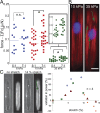Contractility of single cardiomyocytes differentiated from pluripotent stem cells depends on physiological shape and substrate stiffness
- PMID: 26417073
- PMCID: PMC4611612
- DOI: 10.1073/pnas.1508073112
Contractility of single cardiomyocytes differentiated from pluripotent stem cells depends on physiological shape and substrate stiffness
Abstract
Single cardiomyocytes contain myofibrils that harbor the sarcomere-based contractile machinery of the myocardium. Cardiomyocytes differentiated from human pluripotent stem cells (hPSC-CMs) have potential as an in vitro model of heart activity. However, their fetal-like misalignment of myofibrils limits their usefulness for modeling contractile activity. We analyzed the effects of cell shape and substrate stiffness on the shortening and movement of labeled sarcomeres and the translation of sarcomere activity to mechanical output (contractility) in live engineered hPSC-CMs. Single hPSC-CMs were cultured on polyacrylamide substrates of physiological stiffness (10 kPa), and Matrigel micropatterns were used to generate physiological shapes (2,000-µm(2) rectangles with length:width aspect ratios of 5:1-7:1) and a mature alignment of myofibrils. Translation of sarcomere shortening to mechanical output was highest in 7:1 hPSC-CMs. Increased substrate stiffness and applied overstretch induced myofibril defects in 7:1 hPSC-CMs and decreased mechanical output. Inhibitors of nonmuscle myosin activity repressed the assembly of myofibrils, showing that subcellular tension drives the improved contractile activity in these engineered hPSC-CMs. Other factors associated with improved contractility were axially directed calcium flow, systematic mitochondrial distribution, more mature electrophysiology, and evidence of transverse-tubule formation. These findings support the potential of these engineered hPSC-CMs as powerful models for studying myocardial contractility at the cellular level.
Keywords: cardiomyocyte; contractility; sarcomeres; single cell; stem cell.
Conflict of interest statement
The authors declare no conflict of interest.
Figures




References
-
- Dorn GW, II, Molkentin JD. Manipulating cardiac contractility in heart failure: Data from mice and men. Circulation. 2004;109(2):150–158. - PubMed
-
- Lodish HF, et al. Molecular Cell Biology. 7th Ed. W. H. Freeman; New York: 2012. Myosin-powered movements; pp. 801–805.
Publication types
MeSH terms
Grants and funding
LinkOut - more resources
Full Text Sources
Other Literature Sources

